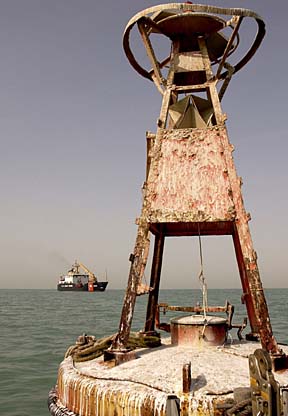
ASSOCIATED PRESS
This worn-out Iraqi buoy will be replaced with a new one by the crew of the U.S. Coast Guard Cutter Walnut, off the coast of Iraq in the North Arabian Gulf. The cuter, based in Honolulu, is replacing buoys in the Khor Abd Allah Waterway to ensure safe transit for vessels sailing to the port of Umm Qasr including vessels carrying humanitarian aid to Iraq.
Isle Coast Guard
buoys Iraqi safetyThe cutter Walnut helps
secure devices for navigation
around coastal waters
Forty days' sail from its familiar waters off Hawaiian shores, a U.S. Coast Guard vessel is replacing buoys and helping secure coastal waters around newly conquered Iraq.
Buoys that guide ships along the Khor Abd Allah Waterway flowing into the main Iraqi port of Umm Qasr are in serious disrepair and way out of place, says Lt. Rick Wester, executive officer of the cutter Walnut.
"They are intended to be an aid to navigation and most of them are a hazard to navigation," said Wester in a telephone interview from Iraq. Wester is also a spokesman for the Coast Guard in Honolulu, where he's used to dealing with illegal drift nets, civilian rescues and other domestic coastline challenges.
The ship's commander, Lt. Cmdr. Chris Smith, said the buoy replacements will help ensure the safety of military, humanitarian aid and commercial ships heading into the critical Iraqi port.
The 225-foot Walnut, one of a series of U.S. buoy tenders named for trees, is the first of its type to be sent into a war zone. It left Honolulu in January for Guam, Singapore, Kuwait and then Iraq.
Wester says, however, it's not the first Coast Guard ship to go to war. Coast Guard cutters and earlier model buoy tenders served during World War II, Vietnam, Grenada and the aborted U.S. invasion of Haiti.
The Walnut's original mission in Iraq was to deal with a possible terrorist act that might result in an oil spill. The buoy tender has a 400-gallon per minute skimming capacity.
The ship's crew had undergone two months of weapons and force protections training and had drills in chemical, biological and radiological attack response while en route to the Gulf, Wester said.
When no environmental disaster occurred, the little Coast Guard ship pulled interdiction duty under U.N. sanctions, boarding ships entering Iraqi waters.
One big ship was hauling 420 containers, and it took a day of climbing over the cargo to check it all. No violations were found, Wester said.
There were some uncertain moments, but the boarded ship's crews generally welcomed the sight of a U.S. Coast Guard ship in Iraqi waters, Wester said.
An exciting moment came when the Walnut crew first entered the Persian Gulf.
"One afternoon, radar indicated a group of contacts approaching Walnut's stern doing about twice its speed," Wester said. "The contacts drew closer, and the lookout reported a larger carrier battle group on the horizon overtaking Walnut."
For a moment it looked as if Walnut was "at the tip of the spear," leading the U.S. carrier battle group into the Gulf, Wester said, but the Navy dismissed the Walnut during the transit as a "slow-moving Coast Guard asset."
On its Gulf mission, the Walnut also was used to carry Navy equipment from Hawaii to Kuwait, refueled a stranded Iraqi civilian tug, helped in recovery efforts for two British helicopters that collided and rescued a five-member port security crew caught in heavy seas.
The Walnut's 50-member Honolulu crew had a stroke of luck in its buoy repair duties when 30 brand new buoys were found in an Iraqi warehouse. That made it a relatively simple operation to bolt high-tech solar lighting units onto the buoys and simply replace the 30 rusted, barnacle-encrusted Iraqi devices in the channel.
Wester said the operations should take about two more weeks, and then Walnut expects to begin the long journey home.
